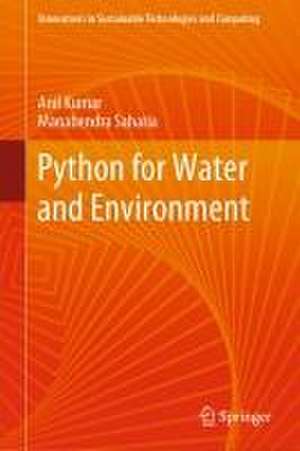Python for Water and Environment: Innovations in Sustainable Technologies and Computing
Autor Anil Kumar, Manabendra Sahariaen Limba Engleză Hardback – 9 mar 2024
Preț: 653.38 lei
Preț vechi: 816.73 lei
-20% Nou
Puncte Express: 980
Preț estimativ în valută:
125.08€ • 130.51$ • 104.85£
125.08€ • 130.51$ • 104.85£
Carte disponibilă
Livrare economică 20 februarie-06 martie
Preluare comenzi: 021 569.72.76
Specificații
ISBN-13: 9789819994076
ISBN-10: 9819994071
Pagini: 288
Ilustrații: XIX, 288 p. 92 illus., 89 illus. in color.
Dimensiuni: 155 x 235 mm
Greutate: 0.64 kg
Ediția:2024
Editura: Springer Nature Singapore
Colecția Springer
Seria Innovations in Sustainable Technologies and Computing
Locul publicării:Singapore, Singapore
ISBN-10: 9819994071
Pagini: 288
Ilustrații: XIX, 288 p. 92 illus., 89 illus. in color.
Dimensiuni: 155 x 235 mm
Greutate: 0.64 kg
Ediția:2024
Editura: Springer Nature Singapore
Colecția Springer
Seria Innovations in Sustainable Technologies and Computing
Locul publicării:Singapore, Singapore
Cuprins
Data Analysis in the Water and Environment.- Python Environment and Basics.- Python Essentials.- Exploratory Analysis of Hydrological Data.- Graphical Hydrological Data Analysis.- Curve Fitting and Regression Analysis.- Hydrological Time Series Analysis.- Common Hypothesis Testing.- Uncertainty Estimation.- Introduction.- Surface Flow Models.- Subsurface Flow Models.- Transport Phenomena.- Contaminant Transport Models.- Conclusion.
Notă biografică
Dr. Manabendra Saharia is an assistant professor in the Department of Civil Engineering and an associate faculty member of the Yardi School of Artificial Intelligence at the Indian Institute of Technology Delhi. Prior to joining IIT Delhi, he held positions in the hydrology labs of the NASA Goddard Space Flight Center and the National Center for Atmospheric Research (NCAR). He received his Ph.D. in Water Resources Engineering from the University of Oklahoma. At IIT Delhi, his HydroSense research lab focuses on utilizing physics and data-driven techniques to monitor and mitigate natural hazards such as floods and landslides. He has been recognized for his scientific contributions, having received Young Scientist awards from both the National Academy of Sciences, India (NASI), and the International Society for Energy, Environment and Sustainability (ISEES).
Dr. Anil Kumar is a senior project scientist in the Department of Civil Engineering at the Indian Institute of Technology Delhi. He received his Ph.D. in Computational Geosciences jointly from Monash University (Australia) and the Indian Institute of Technology Bombay (India). He received a B.Tech. in Geophysical Technology from the Indian Institute of Technology Roorkee. He has been working as a researcher in the field of machine learning and numerical modeling and has helped develop innovative solutions for the oil, gas, and mining industry.
Textul de pe ultima copertă
This textbook delves into the practical applications of surface and groundwater hydrology, as well as the environment. The Part I, "Practical Python for a Water and Environment Professional," guides readers through setting up a scientific computing environment and conducting exploratory data analysis and visualization using reproducible workflows. The Part II, "Statistical Modeling in Hydrology," covers regression models, time series analysis, and common hypothesis testing. The Part III, "Surface and Subsurface Water," illustrates the use of Python in understanding key concepts related to seepage, groundwater, and surface water flows. Lastly, the Part IV, "Environmental Applications," demonstrates the application of Python in the study of various contaminant transport phenomena.
Caracteristici
Addresses the fundamental modeling problems in water resources and hydrology Depicts examples in Python programming language Induces a short learning-curve to advanced numerical techniques such as the finite elements





